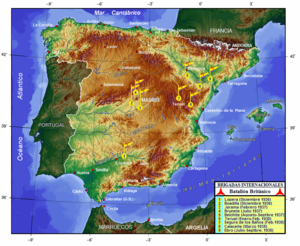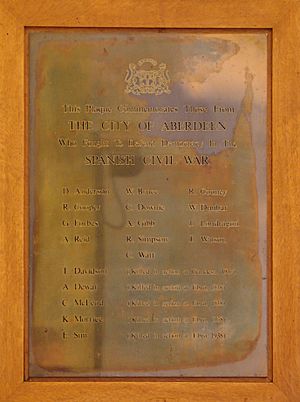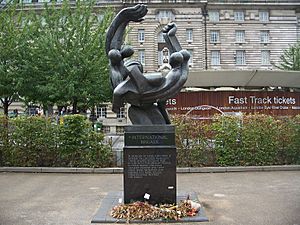British Battalion facts for kids
Quick facts for kids Shapurji Saklatvala BattalionBritish Battalion |
|
|---|---|
| Active | January 1937 – October 1938 |
| Country | |
| Allegiance | |
| Branch | |
| Type | Battalion – Infantry |
| Size | One battalion |
| Part of | XV International Brigade |
| Garrison/HQ | Albacete |
| Nickname(s) | Batallón Británico |
| Engagements | Spanish Civil War |
The British Battalion was a group of brave volunteers from Britain and other Commonwealth countries. They fought in the Spanish Civil War from 1936 to 1938. This battalion was part of the XV International Brigade, a larger group of international volunteers. They went to Spain to help the elected government fight against a rebel army led by General Francisco Franco.
Contents
History of the British Battalion
The British Battalion was a key part of the International Brigades. These brigades were made up of volunteers from many different countries. They all came to Spain to support the government against the rebels.
Early British Volunteers
Some of the first British volunteers arrived in Spain in late 1936. They included people like Tom Wintringham and nurses such as Annie Murray. These early groups often joined other international units. For example, some fought with German-speaking or French-speaking battalions. They took part in important battles, like the Siege of Madrid. This was a long and tough fight to defend the capital city.
Forming the Battalion
In January 1937, a larger group of about 450 British, Irish, and other volunteers came together. They formed their own English-speaking battalion. This new group had three companies of infantry (soldiers who fight on foot) and one company with machine guns.
The battalion was officially named the "Saklatvala Battalion" after a famous British politician. However, everyone usually called it the "British Battalion." The Spanish people also called it "el batallón británico" (the British battalion) or "el batallón inglés" (the English battalion). One of its companies was even named the "Major Attlee Company" after the leader of the British Labour Party, Clement Attlee, who visited the volunteers.
The British Battalion became the 16th battalion of the XV International Brigade. This brigade also included American, Balkan, and French-Belgian battalions.
Battle of Jarama, 1937
In February 1937, the battalion faced its first major challenge at the Battle of Jarama. This was a very difficult and bloody fight. On one day, the British Battalion lost 275 soldiers. Only 125 were still able to fight. The machine gun company was surrounded, and many were captured.
The battalion commander, Tom Wintringham, was injured. Jock Cunningham took over leadership of the remaining 140 soldiers. Despite heavy losses, the battalion showed incredible bravery. They even launched a counter-attack, singing their anthem, the Internationale. This moment became known as the "Great Rally." The battalion stayed in the trenches at Jarama for many months.
Battle of Brunete, 1937
After Jarama, new volunteers joined the battalion, and injured soldiers returned. The British Battalion then had 331 fighters for the Battle of Brunete. In July, they helped capture several villages. During this battle, Alex McDade, who wrote the famous song Valley of Jarama, was killed.
The battalion was ordered to attack Mosquito Ridge, a high piece of land. As they moved, they were bombed by German aircraft and shelled by enemy artillery. The intense fighting and heat caused many casualties. Only 42 members of the battalion were left fit to fight. The battalion then had to pull back.
Aragon Campaign, 1937
In August, the British Battalion moved to the Aragon region. The goal was to draw enemy attacks away from other areas and capture the city of Zaragoza. On August 25, the battalion fought in the streets to capture a strong enemy position in Quinto. The fighting was very tough.
The next day, they attacked Purburrel Hill. They faced heavy rifle and machine gun fire. With support from their anti-tank artillery, they finally succeeded. However, the battalion was reduced to only 100 men. Spanish soldiers were brought in to help fill their ranks.
Later Battles: Teruel and Ebro, 1938
The British Battalion continued to fight in other major battles. These included the Battle of Teruel in 1938 and the Battle of the Ebro later that year. These were some of the largest and most important battles of the Spanish Civil War.
Disbanding the Brigades
On September 21, 1938, the Spanish government announced that it would send the International Brigades home. The British Battalion was pulled from the front lines. On October 17, the battalion took part in a big farewell parade in Barcelona. Many people, including the Spanish President and Prime Minister, cheered for them.
When the battalion was disbanded, 305 British volunteers left Spain. They arrived back at Victoria Station on December 7. A large crowd of supporters, including important politicians, welcomed them home.
Who Was in the Battalion?
The British Battalion was made up of people from different parts of the United Kingdom and beyond.
Welsh Members
About 300 people from Wales joined the International Brigades. Of the 170 Welsh volunteers in the British Battalion, 116 were miners. Many were older than 30, and some were married. Miners from South Wales formed the largest group from any single region in the battalion.
Scottish Members
Around 500 volunteers from Scotland went to Spain to fight against fascism. Many were working-class members of the Communist Party. They often traveled on foot over the Pyrenees mountains to reach Spain. A Scottish Ambulance Unit also went to Spain. It provided food and, more importantly, first aid and medical care for the wounded soldiers.
Irish Members
The battalion also included a group of Irish volunteers. They had previously formed their own unit called the "James Connolly Company." Some of these Irish volunteers had strong Irish beliefs and were not always happy in the British Battalion. However, their leader, Frank Ryan, stressed that working together was more important than national differences. Because of these feelings, some Irish volunteers later joined the American Lincoln Battalion, which was also part of the XV Brigade.
International Brigade Memorial Trust
The International Brigade Memorial Trust (IBMT) is an organization created by veterans and historians. Its goal is to protect and share the history of the British Battalion and other British volunteers.
Roll of Honour
The IBMT has created a special list called the "Roll of Honour." This list names all the members of the British Battalion who died fighting in Spain. The information for this list comes from important historical documents.
Famous Members
Many notable people served in the British Battalion. Here are a few:
- Bill Alexander – He became the commander of the British Battalion in 1938.
- Christopher Caudwell – A journalist and poet who died in action at Jarama.
- Lewis Clive – An Olympic gold medalist in rowing.
- Jack Jones – He later became a very important trade union leader.
- Laurie Lee – A famous poet and writer, known for his book about his experiences.
- Stephen Spender – A well-known poet and professor.
- Tom Wintringham – A journalist and writer who commanded the British Battalion early on.
- Annie Murray - A Scottish nurse, one of the first British volunteers, who helped the wounded.
See Also
- Viva la Quinta Brigada – A song about the International Brigades.





